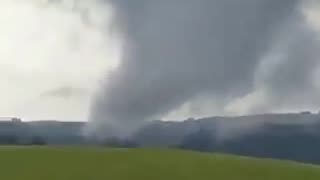Aerials of Fort Myers, Cape Coral, Bonita Springs, Sanibel after Hurricane Ian
Aerials of Fort Myers, Cape Coral, Bonita Springs, Sanibel after Hurricane Ian
Hurricane Ian was a deadly and extremely destructive Category 5 Atlantic hurricane, which was the third-costliest weather disaster on record worldwide, the deadliest hurricane to strike the state of Florida since the 1935 Labor Day hurricane, and the strongest hurricane to make landfall in Florida since Michael in 2018.
Ian caused widespread damage across western Cuba, Florida, and the Carolinas. Ian was the ninth named storm, fourth hurricane, and second major hurricane of the 2022 Atlantic hurricane season. Ian was the first Category 5 hurricane in the Atlantic since Lorenzo in 2019
On September 29, Lee County Sheriff Carmine Marceno, whose jurisdiction covers Cape Coral and Fort Myers, estimated that thousands of people may still be trapped in floodwaters. President Biden said the storm could end up as the deadliest in Florida's history. In an interview on September 29, Marceno said that hundreds of deaths may have occurred, but he and Governor DeSantis later downplayed the remark.
According to the Florida Medical Examiners Commission, as of February 3, 2023, 149 people were confirmed to have died across Florida as a direct result of Hurricane Ian. 72 of those deaths occurred in Lee County, and 9 occurred in neighboring Charlotte County. In the Florida Keys, seven Cuban migrants drowned when their boat capsized off Stock Island, in Monroe County, as Ian moved through; 11 others were missing. In addition, ten people died in Sarasota and Collier Counties; seven in Monroe and Volusia Counties; five in Hillsborough, Manatee, and Osceola Counties; four in Hardee County; three in Orange and Putnam Counties; two each in Hendry and Polk Counties; and one each in DeSoto, Lake, and Martin, Miami-Dade and St. Lucie Counties. Ian also caused two indirect deaths in Sarasota County, a 94-year-old man, and an 80-year-old woman, both due to disabled oxygen machines that they were using. Another from Lee County reportedly died by suicide after seeing the extent of damage done to his property after the storm.[103]
Overall, more than 2.4 million people in Florida lost power during the storm and in its aftermath. Rainfall in Ponce Inlet was recorded at 31.52 inches (801 mm). Total damage in Florida was estimated at $109.5 billion.
A tropical cyclone is a rapidly rotating storm system characterized by a low-pressure center, a closed low-level atmospheric circulation, strong winds, and a spiral arrangement of thunderstorms that produce heavy rain and squalls. Depending on its location and strength, a tropical cyclone is referred to by different names, including hurricane (/ˈhʌrɪkən, -keɪn/), typhoon (/taɪˈfuːn/), tropical storm, cyclonic storm, tropical depression, or simply cyclone. A hurricane is a strong tropical cyclone that occurs in the Atlantic Ocean or northeastern Pacific Ocean, and a typhoon occurs in the northwestern Pacific Ocean
Types of Damage Due to Hurricane Winds
Category 1 74-95 mph
64-82 kt
119-153 km/h Very dangerous winds will produce some damage: Well-constructed frame homes could have damage to roof, shingles, vinyl siding and gutters. Large branches of trees will snap and shallowly rooted trees may be toppled. Extensive damage to power lines and poles likely will result in power outages that could last a few to several days.
Cat 2 96-110 mph
83-95 kt
154-177 km/h Extremely dangerous winds will cause extensive damage: Well-constructed frame homes could sustain major roof and siding damage. Many shallowly rooted trees will be snapped or uprooted and block numerous roads. Near-total power loss is expected with outages that could last from several days to weeks.
Cat 3
(major) 111-129 mph
96-112 kt
178-208 km/h Devastating damage will occur: Well-built framed homes may incur major damage or removal of roof decking and gable ends. Many trees will be snapped or uprooted, blocking numerous roads. Electricity and water will be unavailable for several days to weeks after the storm passes.
Cat 4
(major) 130-156 mph
113-136 kt
209-251 km/h Catastrophic damage will occur: Well-built framed homes can sustain severe damage with loss of most of the roof structure and/or some exterior walls. Most trees will be snapped or uprooted and power poles downed. Fallen trees and power poles will isolate residential areas. Power outages will last weeks to possibly months. Most of the area will be uninhabitable for weeks or months.
CAT 5
(major) 157 mph or higher
137 kt or higher
252 km/h or higher Catastrophic damage will occur: A high percentage of framed homes will be destroyed, with total roof failure and wall collapse. Fallen trees and power poles will isolate residential areas. Power outages will last for weeks to possibly months. Most of the area will be uninhabitable for weeks or months.
Rumble Video is growing fast. To Subscribe to channels, comment or upload videos make your free account here
https://rumble.com/register/F5Tornado/
-
 0:47
0:47
Earth Wind and Fire
7 days agoTornado hits rural areas of Rio Grande do Sul, Brazil
272 -
 9:28
9:28
ThinkStory
1 day agoOUTER RANGE Season 2 Ending Explained!
17.9K8 -
 16:43
16:43
TudorDixon
1 day agoHow was Harrison Butker Wrong? | The Tudor Dixon Podcast
19.7K46 -
 2:39:22
2:39:22
Drunk3PO
19 hours agoStar Wars, Achromatic Chronicles Green, & More | Drunk3po Live
23.5K8 -
 7:11
7:11
Film Threat
1 day agoTHE STRANGERS: CHAPTER 1 | Film Threat Reviews
13.4K4 -
 25:22
25:22
MYLUNCHBREAK CHANNEL PAGE
18 hours agoTartaria, Russia & The Old World?
18.8K36 -
 15:08
15:08
justintech
23 hours agoCorsair Vengeance i8200 Review - 14900K + 4090
15.6K2 -
 11:31
11:31
ryanhoguepassiveincome
17 hours agoTOP 5 NICHES 🔥 Print on Demand Niche Research # 207 — (5/12/2024)
17K6 -
 51:31
51:31
Science & Futurism with Isaac Arthur
1 day agoAutomated Justice
18.5K7 -
 28:23
28:23
TampaAerialMedia
1 day agoMiami Travel Guide - Downtown, Key Biscayne, Coral Gables
12.5K2